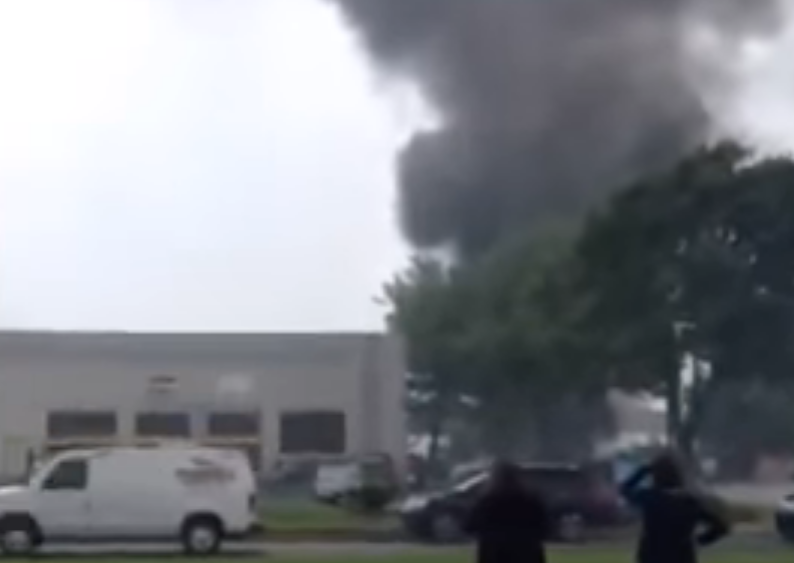
New Castle – The NTSB has released it’s preliminary report involving the helicopter crash that killed a pilot in New Castle last month.
On May 25, 2017, at 1153 eastern daylight time, a Eurocopter Deutschland GMBH EC 135 P2, N62UP, was destroyed when it impacted terrain near New Castle, Delaware.
The airline transport pilot was fatally injured. The helicopter was registered to the University of Pennsylvania and operated by Metro Aviation as a 14 Code of Federal Regulations Part 91 flight. Instrument meteorological conditions prevailed about the time of the accident, and the flight was operated on an instrument flight rules (IFR) flight plan.
The flight originated from Atlantic City International Airport (ACY), Atlantic City, New Jersey, about 11:15 a.m. According to the operator, the helicopter was refueled prior to departure, and the purpose of the flight was for the pilot to practice instrument approach procedures.
Preliminary review of radar and voice communication data provided by the Federal Aviation Administration (FAA) revealed that air traffic control cleared the helicopter for the ILS RWY 1 approach at ILG. The radar track depicted the helicopter established on the final approach course about 2,000 ft mean sea level (msl) which was both the assigned altitude and the intermediate minimum descent altitude for the approach.
The helicopter maintained 2,000 ft msl as it continued through the glide slope and crossed over the locator outer marker. The published crossing altitude for the outer marker while established on the glide-slope was 1,842 ft. The helicopter continued towards the landing runway about 3 miles beyond the outer marker on course about 2,000 ft msl when the pilot declared a missed approach.
The helicopter then climbed on course to 2,525 ft msl before it turned to the right and descended rapidly. Radar contact was lost at 1,625 ft msl. According to FAA records, the pilot held an airline transport pilot certificate with a rating for rotor-craft-helicopter. Additionally, he held a flight instructor certificate with ratings for helicopter and instrument helicopter, and a private pilot certificate with ratings for airplane single-engine land and instrument airplane.
The pilot’s most recent second-class medical certificate was issued on October 20, 2016. At that time, he reported 4,200 hours of total flight experience, of which, 100 hours were in the previous 6 months.
This is preliminary information, subject to change, and may contain errors. Any errors in this report will be corrected when the final report has been completed.
According to FAA records, the helicopter was manufactured in 2006, and was equipped with two Pratt & Whitney Canada, PW206B2 engines. According to the helicopter maintenance logbook, the most recent approved aircraft inspection program (AAIP) 100-hour inspection was performed on April 25, 2017, at an air frame total time of 5,152.1 hours. Prior to the accident flight, the helicopter air frame total time was 5,163.1 hours. Also, the left and right engines had been operated for 5,168.9, and 5,155.7 total hours; respectively. The helicopter came to rest in a water retention ditch about 3,200 ft prior to the threshold of runway 1. It was fragmented and partially consumed by a post-impact fire.
All the major components of the helicopter were located in the 30 ft by 20 ft area of the main wreckage. An odor of Jet A fuel was noted at the accident site. A fence located about 15 ft from and parallel to the main wreckage location had a 45° angle cut in the top post. In addition, about 5 ft directly under the cut post was a damaged section of fence that had part of a rotor blade embedded in it.
Furthermore, a section of wood was located that exhibited 45° angle cuts on either end. The cockpit and forward section of the fuselage were partially consumed by fire. Control continuity of the cyclic and collective was confirmed to the rotor head from the cockpit through several breaks and fractures. The cyclic, collective, and anti-torque pedals were separated and located in the main wreckage. The rotor head and transmission remained attached, but were separated from the air-frame due to impact.
All four blades of the main rotor remained attached to the rotor head. One blade exhibited impact damage and was not thermally damaged. All other blades were consumed by fire. All pitch links remained attached to the rotor head. The transmission mounts were separated from the helicopter.
The tailboom was impact separated and consumed by fire. The fenestron was impact separated. The tail rotor vanes were bent the opposite direction of rotation and several vanes were impact separated. In addition, several of the vanes exhibited leading edge gouging and rotational scoring. The left engine was impact separated from the engine mounts. The reduction gearbox and the turbo-machine were impact separated. The compressor turbine disc and compressor were rotated by hand.
The left engine power turbine was removed and the drive shaft exhibited torsional deformation and fractures. In addition, the power turbine wheel exhibited rotational scoring. The right engine was impact separated from the engine mounts. The right engine power turbine was removed and the drive shaft exhibited torsional twisting deformation and fractures. In addition, the power turbine wheel exhibited rotational scoring. The central warning panel and Sky Connect tracker unit were retained and sent to the NTSB Recorders Laboratory in Washington, DC for download.

